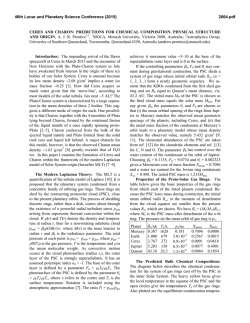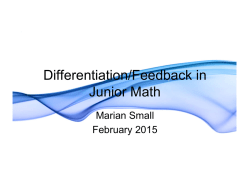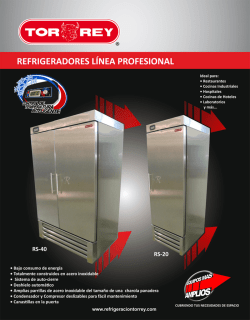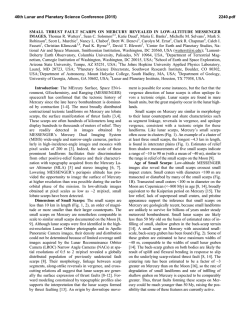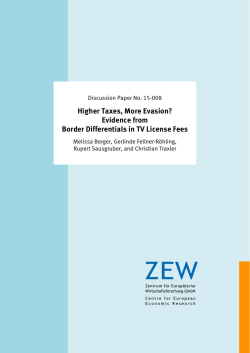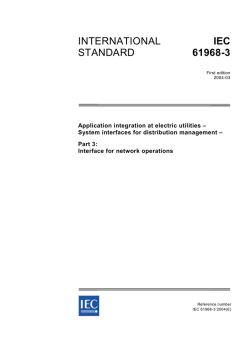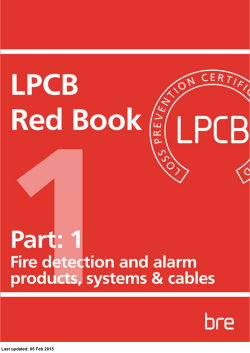
Influence of sedimentary density variations in décollement
GEOGACETA, 60, 2016 Influence of sedimentary density variations in décollement-related fold-and-thrust belts: insights from centrifuge analogue modelling Influencia de las variaciones de la densidad en la cobertera de los cinturones de pliegues y cabalgamientos: aportación de la modelización analógica en centrifugadora Pablo Santolaria1, Ruth Soto2 and Lyal B. Harris3 1 Departamento de Ciencias de la Tierra, Facultad de Ciencias, Universidad de Zaragoza, C/ Pedro Cerbuna 12, 50009 Zaragoza, Spain. [email protected] 2 Instituto Geológico y Minero de España, Unidad de Zaragoza, C/ Manuel Lasala 44, 9B, 50006 Zaragoza, Spain. [email protected] 3 Institut National de la Recherche Scientifique-Centre Eau, Terre et Environnement. 490, rue de la Couronne, G1K9A9, Québec, Canada. [email protected] ABSTRACT RESUMEN We present an innovative centrifuge analogue modelling approach to evaluate the influence of density contrast on structure location and vergence affecting thin-skinned compressional settings. Our natural prototype involves a detached foreland basin characterized by a basal ductile evaporitic décollement overlain by a brittle-like cover comprising a set of rock density variations. The experimental programme included gravity spreading and shortening characterized by density contrast up to 0.5 gr/cm3. Density contrast boundaries were designed perpendicular to the shortening except for one case, where it was parallel. Under no horizontal stress conditions, i.e. the tectonically quiescence context, just the centrifuge force (up to almost 900g), the cover depicts a syncline-anticline structure were the inflexion point was localized along the density contrast boundary. Moreover, wavelength and amplitude increased following the density contrast rise. In compression, density contrast boundaries perpendicular to the shortening direction controlled the vergence of the developed structures. Se presenta un estudio basado en la modelización analógica en centrifugadora que analiza la influencia que tienen las variaciones laterales de densidad de las rocas en la localización y vergencia de las estructuras afectadas por una tectónica de piel fina en contextos compresivos. El prototipo natural esta constituido por una cuenca de antepaís cabalgante a favor de un nivel de despegue dúctil sobre el cual se apoya una cobertera frágil caracterizada por variaciones laterales de la densidad. El programa experimental incluye experimentos en ausencia de esfuerzos horizontales y compresivos donde los contrastes de densidad varían por debajo de 0,5 gr/cm3. Los límites entre dominios con diferente densidad son perpendiculares al acortamiento salvo en un caso donde es paralelo. En ausencia de esfuerzos horizontales, aplicando la fuerza centrífuga (hasta 900g) se desarrolla una estructura sinclinal-anticlinal cuyo punto de inflexión coincide con el límite entre diferentes densidades y cuya longitud de onda y amplitud aumentan a medida que aumenta el contraste de densidad. En contextos compresivos, los contrastes de densidad localizados perpendicularmente al acortamiento controlan la vergencia de las estructuras. Key-words: Décollement, gravity spreading, analogue modelling, fold-andthrust belt. Palabras clave: Nivel de despegue, tectónica gravitacional, modelización analógica, cinturones de pliegues y cabalgamientos. Geogaceta, 60 (2016), 19-22 ISSN (versión impresa): 0213-683X ISSN (Internet): 2173-6545 Introducción Structures that developed during the evolution of fold-and-thrust belts root often in décollement levels such as evaporites. Frequency and wavelength of these structures seem to be controlled by thickness variations affecting the brittle cover and the thickness ratio between the brittle cover and the viscous décollement (e.g., Costa and Vendeville, 2002). Other common features of viscous-brittle analogue models are the lack of a dominant vergence, very low taper angles, coeval growth of structures and the rapid localization of deformation Recepción: 10 de febrero de 2016 Revisión: 20 de abril de 2016 Aceptación: 20 de Mayo de 2016 front forelandwards (Graveleau et al., 2012). In addition, lateral variations in sedimentary systems related to lithological gradations and density contrasts within the cover are common features in foreland basins. Based on aforementioned observations we provide further constraints on the evolution of thin-skinned tectonic areas characterized by a basal viscous décollement and lithological variation, which entail density gradation within the cover. Rheological variations obtained by including different materials within the prekinematic series constitute a first order Copyright© 2016 Sociedad Geológica de España / www.geogaceta.com parameter controlling the structure and kinematics in thrust wedges (e.g. Tang et al., 2010). However, analysing the influence of density variations without rheological contrasts remains unsolved. In this work, we isolate and evaluate the influence of density variations affecting the brittle cover during gravity spreading deformation and the development of fold-and-thrust belts characterised by a viscous basal décollement. The influence of this parameter was tested by using centrifuge analogue modelling, which allowed us using a broad choice of materials with different densities and rheologies. Framed on this technique, previous authors 19 GEOGACETA, 60, 2016 Models were run on a PR-7000 centrifuge (INRS-ETE, Quebec City, Canada) upon 900g during several stages. Each stage comprises a 60 s run-up time, a 360 s of effective experimental time and 420 s of slow-down time. Models must be placed vertically in the centrifuge. This entails risky handling processes that could potentially create undesirable side-effects within the models. To minimize this risk, models were protected by a plastic holder. Boundary effects produced by plastic walls and model materials interaction were prevented by adding a silicone strip on the model sides. Scaling parameters (see Yakymchuk et al., 2012 for further details) used in the experimental programme are described in Table I and allows to compare the performed centrifuge analogue models with our natural prototype: a foreland basin subsequently detached over a ductile décollement. We considered two series of models in order to simulate a brittle sedimentary cover overlying a viscous décollement: i) Brittle-viscous packages in a gravity-driven context, without backstop and collapsing wedge, and ii) brittle-viscous packages in a thin-skinned compressional scenario including backstop and collapsing wedge. In this last case, shortening is achieved by a plasticine-silicone wedge that collapses, by the centrifuge force, pushing the backstop forwards. The brittle cover was simulated by Moon SandTM (regular fine-grained silica sand coated by polymer and synthetic rubber binders) and the décollement was represented by silicone putty (Crazy Aaron’s Thinking Putty, CATPTM). To obtain different densities in the brittle cover, regular Moon SandTM (1.5 gr/cm3) and light Moon SandTM (0.6 gr/cm3) were mixed by a given percentage depending on the required final density. Several analyses were performed in the Moon SandTM and silicone to get its cohesion, internal friction coeffi- 20 Nature Model Scaling ratio* 1 mm 1 km 1 x 10-6 Density 1.6 gr/cm3 2.7 gr/cm3 0.5 Gravity 8800 m/s2 9.8 m/s2 898 Deviatoric stress 1.4 x 10 Pa 2.65 x 10 Pa 5.3 x 10-5 Viscosity 1 x 105 Pa·s 1019 Pa·s 1 x 10-15 4 8 5.3 x 1010 Strain rate Time 360 s 5.7 Ma 2 x 10-12 Velocity 0.4 mm/min 3.5 cm/a 5 x 105 Table I. Scaling of series of centrifuge analogue models. *The scaling ratio is the Model to Nature relation for each parameter. Tabla I. Dimensionamiento de los modelos analógicos en centrifugadora. *El factor de dimensionamiento en la relación Modelo-Prototipo Natural para cada parámetro. Model GRAVITY SPREADING Methodology Parameter Length ρ1 ρ2 ρ3 Densities (gr/cm3) M1.A NO contrast Sh Setup - M1.B 1.51 1.01 - - M1.C 1.51 1.11 - - M1.D 1.51 1.32 - - Along strike density contrast NO contrast M2.A COMPRESSION used microlaminates to simulate upper brittle cover materials (e.g. Dixon and Tirrull, 1991) or a mixture of quartz sand and silicone (Corti, 2004). We used Moon SandTM, a non-extensively used material made of silica sand coated by rubber binders that permits to obtain a broad range of densities by mixing its light and dense types. The advantage of this technique resides in its versatility to use materials with different density and viscosity. P. Santolaria, R. Soto and L.B. Harris 59 M2.B 1.51 1.43 1.32 62 M2.C 1.51 1.43 1.32 60 Along strike density contrast M2.D 1.51 1.43 - 60 Table II. Density of the Moon SandTM and simplified setups (Sh–Shortening). See colour figure on the Web. Tabla II. Densidad de la Moon SandTM y construcción simplificada de los modelos (Sh–Acortamiento). Ver figura en color en la Web. cient and density and its density and viscosity, respectively. For further information and laboratory procedures see Santolaria (2015). The gravity-driven deformation models consisted in a rectangular basal décollement with two lateral pinch-outs (Table II, upper figure). Its lateral continuation was made of regular Moon SandTM. In these experiments, the cover was characterized by an abrupt and vertical discontinuity separating two different density-based domains. It is worth noticing that there was no mechanical discontinuity between each domain since different Moon SandTM mixed during model building. We performed four different models having density contrast of 0.5 gr/cm3, 0.4 gr/cm3 and 0.19 gr/cm3 and 0 (Table II). Models were introduced in the centrifuge and run over 10 times (which is equivalent to 50 minutes under centrifugal acceleration upon 8800 m/s2, i.e. 898 times the Earth's gravity acceleration). Geología Estructural y Tectónica / Structural Geology and Tectonics Influence of sedimentary density variations in décollement-related fold-and-thrust belts: insights from centrifuge analogue modelling GEOGACETA, 60, 2016 In shortening experiments, décollement is in direct contact with the backstop and it presents a distal pinch out perpendicular to the shortening direction. Within this context, we performed four different experiments: the first one involves a layered cover with no density contrast (there was not neither vertical nor horizontal behaviour contrast, layers just differ in colour): two of them (M2.B and M2.C) involved vertical forelandwards, i.e. perpendicular to shortening direction, density discontinuities (differences of around 0.10 g/cm3); and the third one (M2.D) included a longitudinal (i.e. parallel to shortening direction) density discontinuity extending along the whole length across the inner part of the model (Table II). The first model (M2.B) was run under compression up to 7 times reaching 62 mm of shortening. The next two models (M2.C and M2.D) were run, in a tectonically inactive setting, up to 7 times and then under compression 7 times more to reach 60 mm of shortening. Centrifuge analogue models in gravity spreading deformation No remarkable structural changes were observed in models without density contrast in the cover (M1.A). However, the densitycontrasted analogue models (M1.B, M1.C and M1.D) showed a bended cover depicting a syncline-anticline-like geometry where the inflection point coincides with the density discontinuity (Fig. 1). More precisely, the syncline structure is related to the cover load characterized by higher density, while anticlines were defined by the cover uplift where the density was lower. Folds were asymmetrical as they present steeper limbs towards the density discontinuity. Syncline-anticline wavelength and amplitude increased following the rise in density contrast (Fig. 1). Fig. 1.- Interpreted sketches from cross-section at the end of experiments and detail of the structure that developed near the density discontinuity (vertically exaggerated). Dimensions of syncline-anticlines structures are characterized by their wavelength (W) and amplitude (A). Fig. 1.- Esquemas interpretados a partir de cortes realizados tras los experimentos y detalle de las estructuras que se desarrollan en relación a la discontinuidad de densidades (escala vertical exagerada). Las dimensiones de las estructuras sinclinal-anticlinal se caracterizan por su longitud de onda (W) y su amplitud (A). Centrifuge analogue models in compression Shortening was accommodated by means of four structures: i) a box fold or thrust nucleated near the backstop; ii) a frontal anticline and iii) two box-folds that often evolved into thrusts between them. Backwards vergence predominated in models with a cover represented by density contrast whereas no predominant vergence Fig. 2.- Interpreted cross-sections of compressional models. Density is indicated and density discontinuities (D.D.) displayed and labelled. See colour figure on the Web. Fig. 2.- Cortes interpretados de los modelos en compresión. Aparecen las densidades de la cada unidad y las discontinuidades de densidad (D.D.). Ver figura en color en la Web. Geología Estructural y Tectónica / Structural Geology and Tectonics 21 GEOGACETA, 60, 2016 was observed in “null contrasted” model. In M2.B and M2.C, middle structures nucleated within a few millimetres from the density discontinuity (D.D., Fig. 2). Despite Model M2.C was run under gravity spreading deformation prior to the compression run, it presents almost similar structural configuration than M2.C, which was run just under compression. Model M2.D depicts a quite similar structural geometry with no significant differences between the high and low density domains in spite of a noticeable step developed during the quiescent tectonic running. Discussion If “null contrast” model M2.A is compared against density contrasted models, it can be observed that the number of structures remained similar and therefore brittle layer thickness or the brittle-ductile thickness ratio seem to be the controlling factor. However, the vergence of the structures is controlled by the density contrast, i.e. vergence points to the high-density cover, despite a common feature of experimental thrust wedges having a viscous basal décollement overlaid by a brittle cover is the lack of a dominant vergence (Costa and Vendeville, 2002). It can be hypothesized that location of structures in the central part of models M2.B and M2.C was controlled by the presence of the forelandwards (i.e. perpendicular to shortening direction) density discontinuities since these box folds nucleated in the same position where anticlines developed in gravity spreading models, i.e. close and forelandwards of the density discontinuity. One of the main mechanisms that control salt tectonics includes gravitational loading. It involves décollement reorganization responding to the load of the overlying cover and the effect of gravitational forces. Density variations within a constant thickness cover entailed differential loading acting over the décollement that tends to 22 P. Santolaria, R. Soto and L.B. Harris equilibrium and mass reorganization. Interestingly, in gravity spreading models, balancing does not occur along the entire length of the model as predicted by the hydraulic head in fluid statics concepts (Kehle, 1988). Alternatively, balance is achieved by means of local bending of the cover and subsequent décollement migration. Furthermore, bending extension is controlled by the density contrast. Application to the southcentral Pyrenees The south Pyrenean basin acted as a foreland basin during the incipient formation of the Pyrenees. Sedimentation was characterized by the north to south gradation from turbidites, marls and platform limestones whose lithological boundaries where parallel to the growing Pyrenees, specifically in the Jaca basin area. Later on, the south Pyrenean basin was detached over the Triassic evaporites, the regional viscous décollement and developed some south-verging thrust. Lithological variation could entail density variation within the cover. Density of these rocks, as derived from gravity surveys within this area (Calvín et al., 2014; Santolaria 2015), are 2.67 gr/cm3 for limestones, 2.6 gr/cm3 for marls and a mean of 2.55 gr/cm3 for turbidites. Southwards density increase could be one of the triggering factors of the vergence of the structures within this foreland basin as observed in our analogue models where vergence points to the rise of density within the cover. Conclusions Our centrifuge models provided new insights into the geometry and kinematics of fold-and-thrust belts. The results indicated that density variations, inducing differential loading, played a key role in the structural architecture of systems characterized by underlying viscous décollements. Our work showed that this parameter, not extensively tested before due to the limitations of sandpack analogue modelling, can be tested in centrifuge to understand the geometry and kinematics of fold-and-thrust belts. Acknowledgements This work was founded by a research grant from the Sobrarbe Geopark and project KINESAL (CGL2010-21968-C02-02), Spanish Ministry of Economy and Competitiveness, Spain. Funding for first author comes from a DGA-PhD grant (Aragón Government). The authors are indebted the laboratory of physical, numerical and geophysical simulation of the INRS-ETE in Quebec (Canada) where models were performed. We also thank Oriol Ferrer and Javier Fernández Lozano for constructive revisions and Antonio Casas for his helpful suggestions. References Calvín, P., Santolaria, P., Pueyo, E.L. and Casas, A.M. (2014). In: Résumés de la 24e Réunion des Sciences de la Terre, 242. Corti, G. (2004). Tectonophysics 384, 191208. Costa, E. and Vendeville, B., (2002). Journal of Structural Geology 24, 1729-1739. Dixon, J.M. and Tirrul, R. (1991). Journal of Structural Geology 13, 3–20. Graveleau, F., Malavieille, J. and Dominguez, S. (2012). Tectonophysics 538540, 1-66. Kehle, R.O. (1988). In: The origin of salt structures (B.C. Schreiber, Ed.). Columbia University Press, New York, 345-404. Santolaria, P. (2015). Salt and thrust tectonics in the south central Pyrenees. PhD thesis, Zaragoza Univ., 347 p. Tang, P., Vendeville, B.C., Huang, S. and Guillot, Y. (2010). GeoMod 2010, Lisbon, Portugal. Yakymchuk, D., Harris, L.B. and Godin, L. (2012). International Journal of Earth Sciences 101, 463-482. Geología Estructural y Tectónica / Structural Geology and Tectonics
© Copyright 2026

